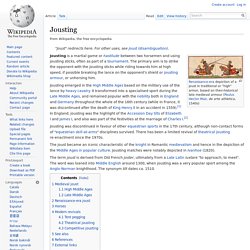

Courtly love. God Speed!

By Edmund Blair Leighton, 1900: a late Victorian view of a lady giving a favor to a knight about to do battle Courtly love was a medieval European conception of nobly and chivalrously expressing love and admiration.[1] Generally, courtly love was secret and between members of the nobility.[2] It was also generally not practiced between husband and wife.[3] The term "courtly love" was first popularized by Gaston Paris in 1883, and has since come under a wide variety of definitions and uses, even being dismissed as nineteenth-century romantic fiction.
Its interpretation, origins and influences continue to be a matter of critical debate. Origin of term[edit] Courtly vignettes on an ivory mirror-case, first third of the 14th century (Musée du Louvre) The term and Paris's definition were soon widely accepted and adopted. Courtly Love comes in the basket History[edit] Andalusian and Islamic influence[edit] According to G. Analysis[edit] Literary convention[edit] Lyric[edit] Romance[edit] Chivalry. Chivalry, or the chivalric code, is a code of conduct associated with the medieval institution of knighthood.

Chivalry arose from an idealized German custom.[1] It developed first in the north of France among horse soldiers who served in Charlemagne′s heavy cavalry.[2] It was originally conceived of as an aristocratic warrior code — the term derives from the French term chevalerie, meaning horse soldiery[3] — involving gallantry, individual training, and service to others. Over time its meaning has been refined to emphasise more ideals such as the knightly virtues of honour, courtly love, courtesy, and less martial aspects of the tradition. The Knight's Code of Chivalry was a moral and honorable system that stated all knights should protect others who can not protect themselves, such as widows, children, and elders. Knights vowed to be loyal, generous, and "of noble bearing".
Knights were required to tell the truth and respect the honour of women. Terminology and definitions[edit] Knight. Some orders of knighthood, such as the Knights Templar, have become the subject of legend; others have disappeared into obscurity.

Today, a number of orders of knighthood continue to exist in several countries, such as the English Order of the Garter, the Swedish Royal Order of the Seraphim, and the Royal Norwegian Order of St. Olav. Each of these orders has its own criteria for eligibility, but knighthood is generally granted by a head of state to selected persons to recognise some meritorious achievement. Knighthood in the Middle Ages was closely linked with horsemanship (and especially the joust) from its origins in the 12th century until its final flowering as a fashion among the high nobility in the Duchy of Burgundy in the 15th century.
This linkage is reflected in the etymology of chivalry, cavalier and related terms (see Etymology section below). Etymology[edit] A narrowing of the generic meaning "servant" to "military follower of a king or other superior" is visible by 1100. Jousting. Jousting emerged in the High Middle Ages based on the military use of the lance by heavy cavalry.

It transformed into a specialised sport during the Late Middle Ages, and remained popular with the nobility both in England and Germany throughout the whole of the 16th century (while in France, it was discontinued after the death of King Henry II in an accident in 1559).[1] In England, jousting was the highlight of the Accession Day tilts of Elizabeth I and James I, and also was part of the festivities at the marriage of Charles I. Jousting was discontinued in favour of other equestrian sports in the 17th century, although non-contact forms of "equestrian skill-at-arms" disciplines survived.
There has been a limited revival of theatrical jousting re-enactment since the 1970s. The term joust is derived from Old French joster, ultimately from a Late Latin iuxtare "to approach, to meet". Medieval joust[edit] High Middle Ages[edit] Late Middle Ages[edit] Renaissance-era joust[edit] Horses[edit]